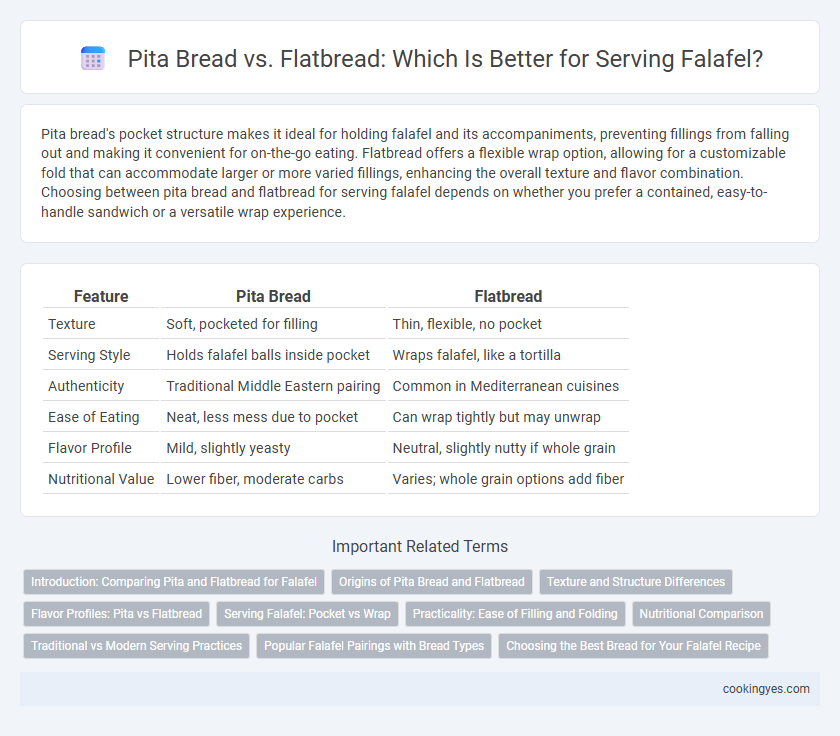Pita bread's pocket structure makes it ideal for holding falafel and its accompaniments, preventing fillings from falling out and making it convenient for on-the-go eating. Flatbread offers a flexible wrap option, allowing for a customizable fold that can accommodate larger or more varied fillings, enhancing the overall texture and flavor combination. Choosing between pita bread and flatbread for serving falafel depends on whether you prefer a contained, easy-to-handle sandwich or a versatile wrap experience.
Table of Comparison
| Feature | Pita Bread | Flatbread |
|---|---|---|
| Texture | Soft, pocketed for filling | Thin, flexible, no pocket |
| Serving Style | Holds falafel balls inside pocket | Wraps falafel, like a tortilla |
| Authenticity | Traditional Middle Eastern pairing | Common in Mediterranean cuisines |
| Ease of Eating | Neat, less mess due to pocket | Can wrap tightly but may unwrap |
| Flavor Profile | Mild, slightly yeasty | Neutral, slightly nutty if whole grain |
| Nutritional Value | Lower fiber, moderate carbs | Varies; whole grain options add fiber |
Introduction: Comparing Pita and Flatbread for Falafel
Pita bread and flatbread serve as popular bases for falafel, each offering unique textures and flavors that complement the crispy, spiced chickpea patties. Pita bread's pocket structure makes it ideal for stuffing falafel alongside fresh vegetables and sauces, while flatbread provides a soft, flexible wrap that evenly distributes ingredients. Selecting between pita and flatbread influences the overall falafel experience by balancing convenience, taste, and traditional presentation.
Origins of Pita Bread and Flatbread
Pita bread, originating from the Middle East around 2500 BCE, is known for its pocket that perfectly holds falafel, providing a convenient and traditional serving method. Flatbread, with ancient roots across various cultures including Egyptian and Mediterranean societies, offers a versatile, open-faced alternative for wrapping falafel. Both breads complement falafel differently, with pita enhancing portability and flatbread allowing for more customizable fillings.
Texture and Structure Differences
Pita bread offers a soft, pocketed structure that securely holds falafel and toppings, preventing spills while providing a chewy texture that complements the crispy exterior of falafel. Flatbread, such as laffa or wraps, features a thinner, more flexible texture that allows for easy rolling but lacks the hollow interior, resulting in a different mouthfeel and requiring careful folding to contain ingredients. The choice between pita and flatbread significantly impacts the eating experience, balancing firmness, pliability, and the capacity to retain falafel and accompaniments.
Flavor Profiles: Pita vs Flatbread
Pita bread offers a soft, slightly tangy flavor with a pocket that holds falafel and toppings, enhancing the overall texture and taste experience. Flatbread presents a more neutral, toasted profile that allows the spices and herbs of falafel to shine without overwhelming them. Both bread types complement falafel uniquely, with pita emphasizing moisture retention and flatbread providing a crisp, subtle base.
Serving Falafel: Pocket vs Wrap
Pita bread, with its built-in pocket, provides a convenient structure for stuffing falafel balls and fillings, keeping all ingredients securely contained for easy, mess-free eating. Flatbread serves as a flexible wrap, allowing for a more customizable and open presentation, making it ideal for larger portions or additional toppings like tahini and vegetables. Choosing pita enhances portability and bite-sized servings, while flatbread offers versatility in layering and rolling falafel with diverse accompaniments.
Practicality: Ease of Filling and Folding
Pita bread offers a convenient pocket structure that securely holds falafel and fillings, preventing spills and making it easy to eat on the go. Flatbread, while flexible and soft, requires careful folding to avoid ingredients falling out, which can be less practical for a mess-free experience. For ease of filling and folding, pita bread is generally preferred due to its sturdier shape and better structural support.
Nutritional Comparison
Pita bread typically offers a higher protein content and more fiber per serving compared to most flatbreads, enhancing the nutritional value of falafel wraps. Flatbread generally contains fewer calories and less fat, making it a lighter option for those monitoring their energy intake. Choosing between pita and flatbread depends on dietary goals, with pita providing more sustained energy and flatbread offering a lower-calorie alternative.
Traditional vs Modern Serving Practices
Pita bread remains the traditional choice for serving falafel, valued for its pocket that holds falafel balls, vegetables, and sauces neatly, preserving the authentic Middle Eastern eating experience. Modern serving practices increasingly favor flatbread, which offers a versatile, open-faced alternative that highlights falafel's texture and flavor while accommodating diverse toppings and contemporary presentation styles. The contrast between pita bread's convenience and flatbread's adaptability reflects evolving culinary trends in falafel consumption worldwide.
Popular Falafel Pairings with Bread Types
Pita bread remains the most popular choice for serving falafel due to its pocket that easily holds falafel balls, along with accompaniments like tahini, hummus, and fresh vegetables. Flatbread, while less common, offers a versatile wrap style that emphasizes a lighter, crispier texture and allows for more flexible fillings without the constraint of a pocket. Both pita and flatbread enhance the falafel experience, with pita favored in traditional Middle Eastern cuisine and flatbread appealing to modern, handheld serving preferences.
Choosing the Best Bread for Your Falafel Recipe
Pita bread is the most popular choice for serving falafel due to its pocket-like structure, which securely holds the falafel balls along with toppings and sauces, ensuring a convenient and mess-free eating experience. Flatbread offers a softer, more flexible option that allows for a wrap-style presentation, ideal for those who prefer a thinner bread texture with a slightly chewy bite. Selecting between pita and flatbread depends on the desired falafel presentation and texture preference, with pita providing sturdiness and tradition, while flatbread enhances versatility and softness.
Pita Bread vs Flatbread for Falafel Serving Infographic

 cookingyes.com
cookingyes.com